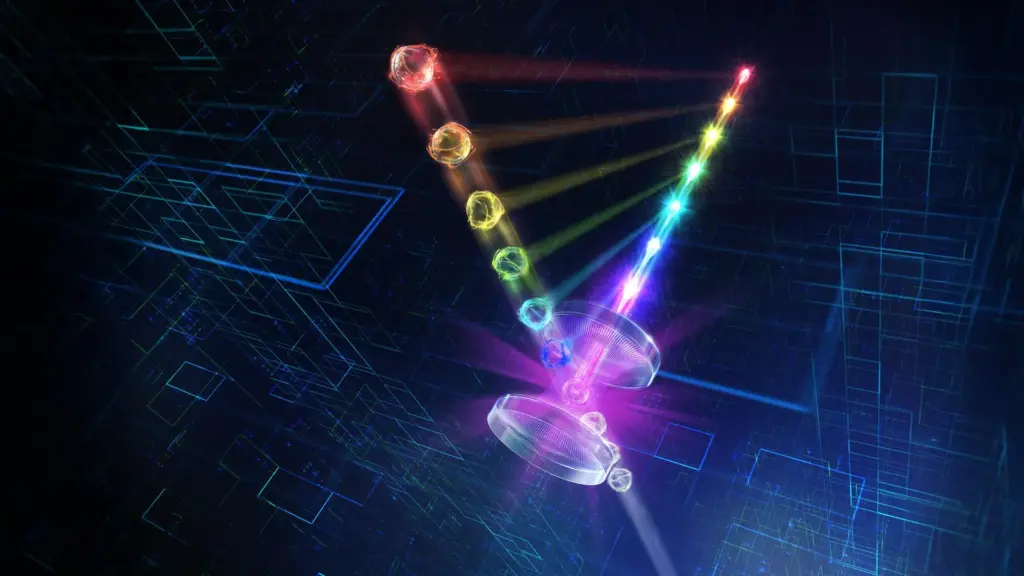Scientists at the University of Innsbruck have achieved a significant breakthrough in quantum networking, paving the way for a future where quantum computers are interconnected across vast distances. Their innovative approach utilizes a chain of calcium ions within a prototype quantum computer to generate entangled photons, effectively creating a node capable of sharing quantum information. This advancement represents a monumental leap towards building a robust and scalable quantum internet.
The implications of this research extend far beyond theoretical advancements. The potential for secure communication, distributed computing, and highly accurate timekeeping systems could reshape various technological landscapes.
What Happened? 📝
The Innsbruck team, led by Ben Lanyon, successfully demonstrated a quantum network node using ten calcium ions trapped within an optical cavity. These ions, acting as qubits (the basic unit of quantum information), were individually manipulated using electric fields. A precisely tuned laser pulse then triggered each ion to emit a single photon, whose polarization became entangled with the ion’s quantum state.
This process resulted in a stream of photons, each linked to a different ion-qubit. Crucially, these photons could, in theory, travel to distant nodes, establishing entanglement between separate quantum devices and forming the basis of a quantum network.
The Significance of Entanglement Fidelity 🔬
The researchers achieved an impressive average ion-photon entanglement fidelity of 92 percent. This high fidelity is a testament to the robustness and reliability of their method. Entanglement fidelity refers to how accurately the quantum state of the ion is transferred to the photon. A higher fidelity means less noise and more reliable information transfer, vital for the successful implementation of quantum networks.
This level of precision significantly surpasses previous attempts, which only managed to link a few ion-qubits to photons. The scalability of this method is a major breakthrough, opening the door for networks involving hundreds, or even thousands, of ions.
Scalability and Future Applications 🚀
One of the most exciting aspects of this research is its scalability. Unlike previous experiments that were limited to a small number of ion-qubits, the Innsbruck setup can be expanded to much larger registers, potentially containing hundreds of ions. This directly addresses a major hurdle in building practical quantum networks.
This scalability opens up a vast array of applications. The researchers highlight the potential for quantum-secure communication (unbreakable encryption), distributed quantum computing (harnessing the power of multiple quantum computers), and large-scale distributed quantum sensing (enhanced precision measurements over wide areas).
Beyond Networking: Impact on Atomic Clocks ⏱️
The technology developed in this research extends beyond quantum networking. It also has the potential to significantly improve the accuracy of optical atomic clocks. These incredibly precise timekeeping devices could be linked via quantum networks to create a global timekeeping system with unparalleled accuracy – a system so precise it would lose less than a second over the entire age of the universe.
Imagine the implications for GPS systems, scientific research, and various technological applications that rely on precise time synchronization. The possibilities are truly transformative.
Key Takeaways 🔑
- Innsbruck scientists demonstrated a scalable quantum network node using ten entangled calcium ions and photons.
- They achieved a remarkable 92% ion-photon entanglement fidelity, showcasing the robustness of their method.
- This breakthrough paves the way for building large-scale quantum networks for secure communication, distributed computing, and quantum sensing.
- The technology also has the potential to revolutionize optical atomic clocks, leading to a global timekeeping system of unprecedented accuracy.
The research published in Physical Review Letters represents a monumental leap forward, joining other recent advancements like the project to democratize quantum sensing. This achievement lays a crucial foundation for the next generation of quantum computing and communication systems. The future of quantum networking is bright, and this research shines a light on the path forward.
Source: Scientists create scalable quantum node linking light and matter



